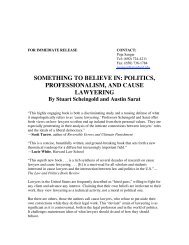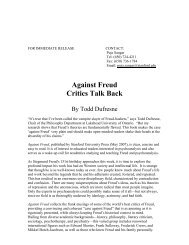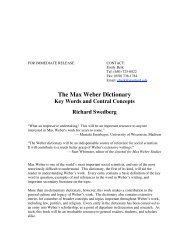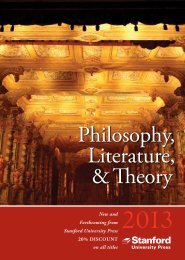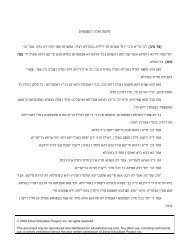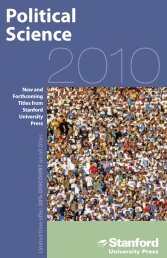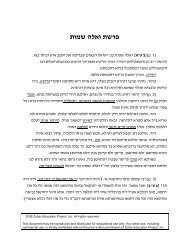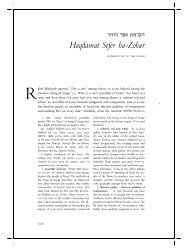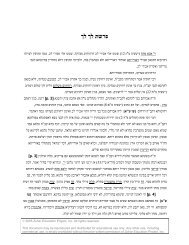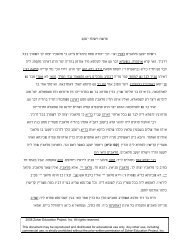Front Matter (PDF) - Stanford University Press
Front Matter (PDF) - Stanford University Press
Front Matter (PDF) - Stanford University Press
You also want an ePaper? Increase the reach of your titles
YUMPU automatically turns print PDFs into web optimized ePapers that Google loves.
e seen as the greatest work of medieval Jewish ``iconography''Ðone that<br />
may<br />
only in the words of the written page, thence to be distilled in the<br />
exists<br />
of its devoted students.<br />
imagination<br />
in a lofty combination of Aramaic and Hebrew, the Zohar was ®rst<br />
Written<br />
to the world around the year 1300. Those who distributed it, orally<br />
revealed<br />
in small written fragments, claimed that it was an ancient text they had<br />
and<br />
rediscovered, and that it had been composed in the circle of those<br />
recently<br />
within its pagesÐRabbi Shim'on son of Yoḥai and his disciples, who<br />
described<br />
in the land of Israel duringthe second century of the Common Era. The<br />
lived<br />
of the Zohar's origins combined with its unique language and its rich<br />
obscurity<br />
imagination to lend to the work an aura of unfathomable mystery.<br />
poetic<br />
a few of the more critical spirits in each century doubted the Zohar<br />
While<br />
questioned its authority, the great majority of readers, and later of Jewry<br />
and<br />
a whole, believed in the Zohar and venerated it, consideringit a holy<br />
as<br />
and a sacred scripture that was to be ranked alongside the Bible<br />
revelation<br />
the Talmud as a divinely inspired source of religious truth. Only in<br />
and<br />
times, and largely for apologetic reasons, was the Zohar deleted from<br />
modern<br />
canon of what was considered ``mainstream'' Judaism.<br />
the<br />
of the Zohar into western languages began as early as the<br />
Translation<br />
century, when passages were rendered into Latin for use by Christian<br />
®fteenth<br />
of esoteric lore in Renaissance Italy. In the twentieth century, various<br />
devotees<br />
of the Zohar, or at least of most sections of it, appeared in<br />
translations<br />
French, and English. The previous standard English translation is<br />
German,<br />
of Harry Sperlingand Maurice Simon, published in 1931±34 by the Sonci-<br />
that<br />
<strong>Press</strong>. no<br />
present translation and commentary by Daniel Matt re¯ect the high<br />
The<br />
of Zohar scholarship that have been achieved in recent decades.<br />
standards<br />
are the result of the new attention paid to Kabbalah in academic circles,<br />
These<br />
thanks to the writings of Gershom Scholem (1897±1982) and the cadre<br />
largely<br />
scholars he and his successors have trained within the Israeli universities.<br />
of<br />
®rst to bringScholem's approach to kabbalistic studies to North American<br />
The<br />
was Alexander Altmann (1906±1987) at Brandeis <strong>University</strong>, whose<br />
shores<br />
include both the translator of these volumes and the author of this<br />
students<br />
Further discussion of the translation and the principles under-<br />
introduction.<br />
may be found in the Translator's Introduction.<br />
lyingit<br />
purpose of this introduction is to equip the reader to better appreciate<br />
The<br />
Zohar text. The translation before you is one that takes full cognizance of<br />
the<br />
poetic spirit in which the Zohar was composed and especially of the<br />
the<br />
tone achieved by its unique use of language. To appreciate these in<br />
elevated<br />
fullest sense, it must be said, the Zohar needs to be read, indeed studied, in<br />
the<br />
original. Like most of the kabbalistic tradition within which it stands, the<br />
the<br />
is entranced with the mysteries of language, in both its oral and written<br />
Zohar<br />
Introduction<br />
xxviii<br />
forms. No translation could do justice to the Zohar's rich and creative appro-



